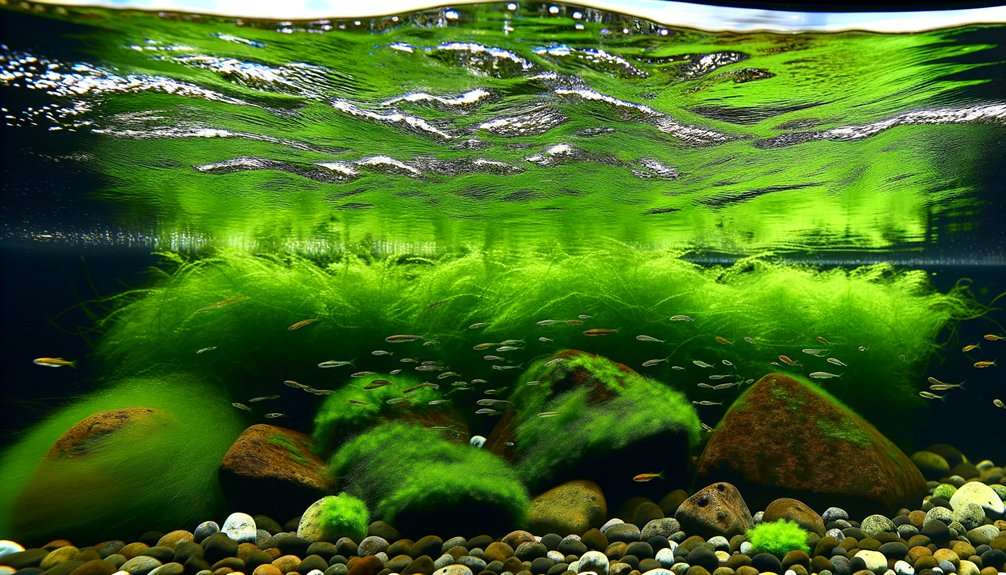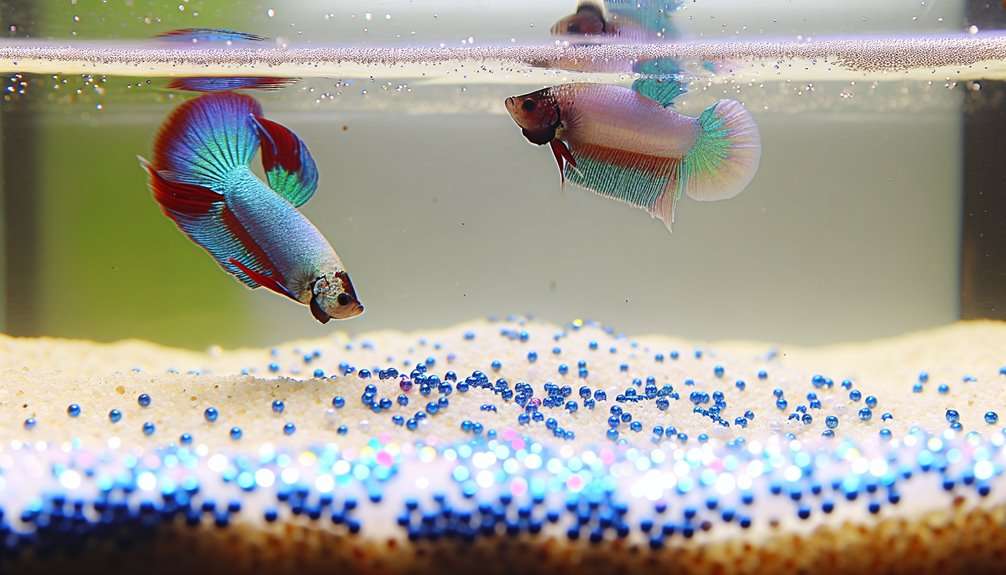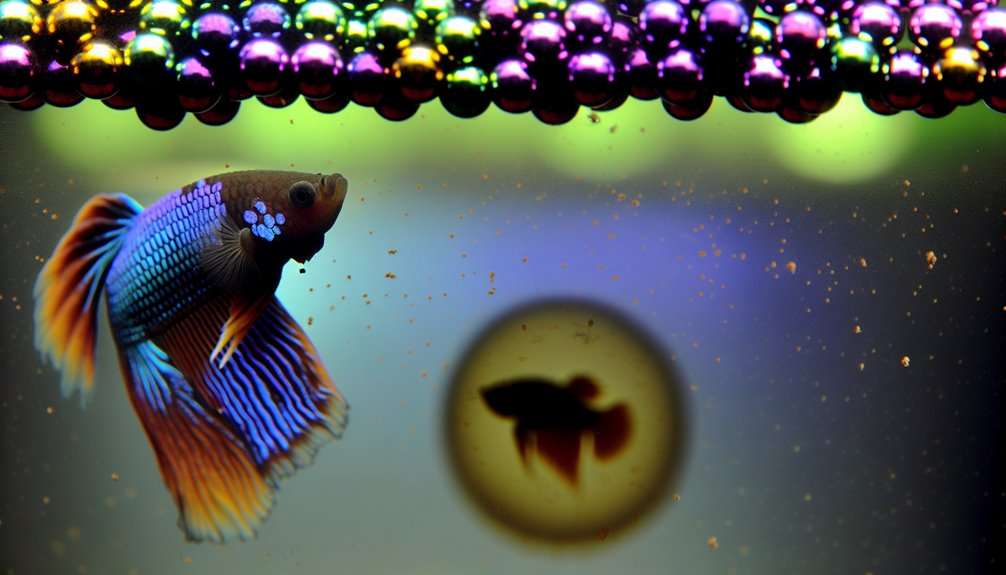Frequent water changes no cycling can maintain a healthy aquarium, but it requires diligent management. Regularly changing 10-20% of the water weekly helps dilute toxins like ammonia and nitrates, essential for fish health. Always match the new water’s temperature and pH to minimize stress on your aquatic life. However, skipping cycling can lead to unstable water parameters and potential ammonia spikes. There’s more to guarantee a thriving aquarium environment, so let’s explore those strategies further.
Blog
-

Green Algae in Fish Tank
Green algae in fish tank the key to a naturally stable aquatic ecosystem. These organisms are vital for healthy aquarium life, acting as a powerhouse filter that absorbs excess nutrients like nitrates and phosphates while producing necessary oxygen. They even provide a valuable natural food source that aids in your fish’s digestion and overall health. When factors like overfeeding or excessive light exposure cause runaway growth, however, you must step in. Maintain balance by utilizing algae-eating fish, optimizing your lighting schedule, and performing routine water changes. Learn how to harness these beneficial organisms to create a thriving, balanced, and low-maintenance tank.
-

Algae-cycled aquarium
Algae-cycled aquarium uses algae’s natural processes to manage waste and enhance water quality. Algae absorb nutrients, preventing harmful buildup while providing oxygen and stabilizing the ecosystem. By maintaining ideal lighting and nutrient levels, you encourage healthy algae growth, which supports a balanced habitat for fish and plants. This approach leads to reduced reliance on chemical treatments. To optimize your algae cycle and tackle common issues, there are more effective strategies you can implement.
-

Aquarium Not Cycling? Stop the Stall!
Aquarium not cycling turning tank setup into a nightmare, you need immediate answers. A stalled nitrogen cycle means toxic ammonia and nitrite are building up, directly threatening your fish’s health. Don’t waste another week! The fix often lies in correcting water parameters, optimizing beneficial bacteria growth, or boosting filtration efficiency. Learn how to quickly diagnose why your cycle won’t finish and get your tank on the fast track to becoming a stable, healthy aquarium today..
-

Are Betta Fish Smart
Are betta fish smart? Yes—these fascinating fish show surprising cognitive abilities that go beyond their reputation as simple aquarium pets. Bettas can recognize their owners, respond to stimuli, and even learn basic tasks, all of which point to a deeper level of awareness. Understanding betta fish intelligence not only enhances how we care for them but also reveals how they interact with their environment in unique ways.
Are Betta Fish Smart :Key Takeaways
- Betta fish can learn to associate behaviors with rewards, demonstrating cognitive abilities similar to some other fish species.
- They recognize feeding patterns and anticipate meals, showcasing their ability to remember routines.
- Betta fish can perform simple tricks, such as swimming through hoops, indicating their capacity for learning.
- They engage in social interactions, recognizing owners and other fish through visual cues and body language.
- A stimulating environment enhances their intelligence, promoting exploration, problem-solving, and overall well-being.
Understanding Betta Fish Behavior
Have you ever wondered how Betta fish interact with their environment? These vibrant fish exhibit fascinating behaviors that reveal their adaptability. They often explore their surroundings, using their long fins to navigate and investigate plants, decorations, and other tank mates. You might notice them flaring their gills and spreading their fins when they feel threatened or want to assert dominance. Betta fish communicate through body language, showing signs of stress or happiness based on their movements and colors. When they’re comfortable, they display bright hues and swim playfully. Providing a stimulating environment with ample hiding spots and space allows them to express their natural behaviors, enhancing both their well-being and your enjoyment of observing them.
-

Do Betta Fish Like Colored Lights?
Do betta fish like colored lights? Yes, they do respond to colored lighting, and different hues can influence their behavior in unique ways. Softer colors often promote calmness and encourage exploration, while brighter or harsher shades may sometimes trigger stress or aggression. By choosing the right balance of lighting, aquarists can create an environment that supports their betta’s natural instincts and overall well-being.
Do Betta Fish Like Colored Lights ? : Key Takeaways
- Betta fish can respond positively to vibrant colors, enhancing their activity and appearance in the aquarium.
- Blue and green lights promote calmness, while red and yellow may trigger aggression in Betta fish.
- Proper lighting stimulates Betta fish’s natural behaviors and regulates their circadian rhythms for overall health.
- Experimenting with colored lights can create an engaging habitat, but a consistent light cycle is essential for well-being.
- LED lights that mimic natural sunlight are recommended for a stress-free environment and vibrant Betta colors.
Understanding Betta Fish Behavior
When you observe Betta fish, you’ll notice they have unique behaviors that reflect their natural instincts. These vibrant creatures are known for their territorial nature, often displaying aggressive postures when they sense another Betta nearby. You might see them flare their fins, puff up their bodies, or swim rapidly in an attempt to assert dominance. Additionally, Betta fish enjoy exploring their environment, so providing hiding spots and plants can stimulate their curiosity. They also exhibit a fascinating feeding behavior; they’ll often dart towards food, mimicking their natural hunting instincts. Understanding these behaviors helps you create a more enriching habitat, ensuring your Betta feels safe and engaged. Observing these traits gives you insight into their needs and preferences as a pet owner.
-

Can Betta Fish See Color?
Can Betta Fish See Color?
Can betta fish see color? The answer is yes—and their vision is far more vibrant and complex than most people realize. Bettas have specialized adaptations that allow them to detect a broad spectrum of colors, even beyond human capability. This heightened color perception plays a key role in their daily behaviors, communication, and mating displays. By understanding how bettas see the world, we gain valuable insight into how they interact with their environment and with each other.
Key Takeaways
- Betta fish have special cone cells that enable them to perceive a wide spectrum of colors, including those invisible to humans.
- Their ability to distinguish subtle color variations helps them identify mates and threats in their environment.
- Brightly colored objects attract Betta fish more than dull ones, influencing their behavior and interactions.
- Color changes in Betta fish can indicate mood and health, with vibrant hues signaling aggression or readiness to mate.
- Proper lighting conditions enhance Betta color perception, affecting their visibility and overall well-being.
The Anatomy of Betta Fish Eyes
The eyes of Betta fish are fascinating structures that play an essential role in their ability to perceive their environment. Located on either side of their head, these eyes provide a wide field of vision, allowing them to detect movement and potential threats. Betta fish have a unique lens shape that enables them to focus on objects both near and far. Their corneas are relatively large, which enhances their ability to capture light, important for maneuvering in dimly lit waters. Additionally, the presence of a tapetum lucidum, a reflective layer behind the retina, improves their night vision. Understanding the anatomy of their eyes can help you appreciate how these beautiful fish interact with their surroundings and respond to changes in their habitat.
-

How to Care for Betta Fish
How to Care for Betta Fish
How to Care for Betta Fish It’s no coincidence that many new fish owners choose Betta fish for their vibrant colors and personalities. However, caring for them properly requires more than just filling a tank with water. You need to take into account their specific needs for a healthy and thriving environment. From ideal tank setups to nutrition and social interactions, every detail matters. Let’s explore what it takes to keep your Betta happy and healthy.
Key Takeaways
- Maintain a minimum tank size of 5 gallons with plants and decorations for hiding spots.
- Keep water temperature between 76°F and 82°F, and pH levels between 6.5 and 7.5.
- Feed high-quality Betta pellets and supplement with frozen or freeze-dried foods, avoiding overfeeding.
- Perform weekly water changes of 25-30% to ensure optimal water quality.
- Monitor behavior and interactions with tankmates, ensuring a peaceful environment.
How to Care for Betta Fish : Betta Fish Behavior
Understanding Betta fish behavior is vital for creating a healthy environment for your pet. These vibrant fish are known for their territorial nature, especially males, so it’s important to provide enough space to avoid aggression. You’ll notice them flaring their fins or displaying colors when feeling threatened or excited. Betta fish also enjoy exploring their surroundings, so adding plants and hiding spots will keep them engaged and active. They communicate through body language and can even recognize their owners, responding to your presence. Keep an eye on their eating habits; if they start refusing food, it may signal stress or health issues. By closely observing these behaviors, you’ll guarantee your Betta thrives in a suitable and enriching environment.
-

Are Betta Beads Safe for Betta Fish?
Are Betta Beads Safe For Betta Fish?
Betta beads can enhance your betta fish’s habitat, but their safety depends on the materials used. Are betta beads safe for betta fish? Some beads may leach harmful substances In To the water, potentially stressing your fish or harming its health.
It’s essential to monitor water quality regularly and choose decorations that won’t pose risks to your betta’s well-being. By making informed choices, you can create a safe and vibrant environment. You’ll discover more about safer alternatives and maintenance tips as you explore this topic.
-

The Hidden Problems With Betta Beads Nobody Talks About
The Hidden Problems With Betta Beads Nobody
Talks About
Betta beads might look nice in your aquarium, but they can harm your bettas’ health. They create stress and can lead to illness, while also trapping debris that compromises water quality. Plus, if your fish accidentally swallow a bead, it could cause serious internal issues. Many beads are also made from unsustainable materials, adding to environmental concerns. There are better, safer alternatives for your tank that won’t put your fish or the planet at risk—discover what they are!
The Hidden Problems With Betta Beads Nobody Talks About
The Hidden Problems With Betta Beads Nobody Talks About include poor bacteria growth, water quality risks, and hidden health issues for bettas.
